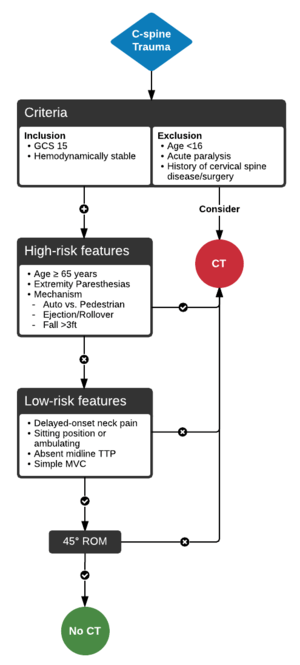Canadian cervical spine rule
Background
- Only applies to GCS=15 and stable blunt neck trauma
- Not applicable for:
- Non-trauma, GCS <15, Hemodynamically unstable, Age <16, Acute paralysis, previous spinal disease or surgery
Rule
Canadian Cervical Spine Rule

Algorithm for evaluation of cervical spine injuries (Canadian C-spine Rule)
No High Risk Factors
- Age >65
- Dangerous mechanism (fall>3ft/5 stairs, high speed MVC (>60mph)/rollover/ejection, bicycle crash, RV, axial load injury)
- Parasthesias in extremities
ANY Low Risk Factor
- Simple rear end MVC
- Delayed onset of pain
- Sitting position in ED
- Ambulatory at any time
- Absence of midline C-spine tenderness
Mnemonic
High Risk Rhyme
- Sixty five,
- Fast drive,
- Sense deprive
- (Image if alive)
Low Risk Rhyme
- Slow wreck,
- Slow neck,
- Sitting down,
- Walking around,
- C-spine fine
- (Range the spine)
See Also
External Links
References
- Stiell IG,et al. The Canadian C-spine rule for radiography in alert and stable trauma patients. JAMA. 2001 Oct 17;286(15):1841-8. EBQ:Canadian C-spine Rule Study
- Stiell IG, et al. The Canadian C-spine rule versus the NEXUS low-risk criteria in patients with trauma. N Engl J Med. 2003;349(26):2510-8.
This article is issued from
Wikem.
The text is licensed under Creative
Commons - Attribution - Sharealike.
Additional terms may apply for the media files.